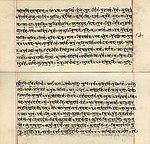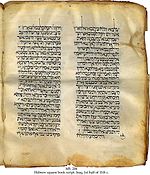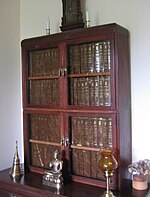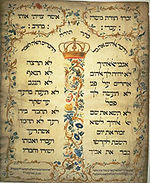Portal:Religion/Selected scripture
Usage
[edit]The layout design for these subpages is at Portal:Religion/Selected scripture/Layout.
- Add a new Selected scripture to the next available subpage.
- Update "max=" to new total for its {{Random portal component}} on the main page.
Selected scriptures list
[edit]Scriptures 1–20
[edit]Portal:Religion/Selected scripture/1
The Qur'ān (Arabic: al-qur’ān, literally "the recitation"; also called al-qur’ān al-karīm "The Noble Qur'ān"; also transliterated as Quran, Koran, and Al-Quran), is the central religious text of Islam. Muslims believe the Qur'ān, in its original Arabic, to be the literal word of God that was revealed to Muhammad over a period of twenty-three years until his death, and believe it to be God's final revelation to humanity. Muslims regard the Qur'ān as a continuation to other divine messages that have started with those revealed to Adam - the first prophet - and including Suhuf-i-Ibrahim (Scrolls of Abraham/Ibrahim), the Tawrat (Torah), the Zabur (Psalms), and the Injil (Gospel), in between. The aforementioned books are recognized in the Qur'ān, but directs Muslims to follow the Qur'ān--the last and final message, being completely untainted with God promising to protect it: "Verily We: It is We Who have sent down the Dhikr (i.e. the Quran) and surely, We will guard it (from corruption)".
The Qur'anic verses were originally memorized by Muhammad's companions as Muhammad recited them, with some being written down by one or more companions on whatever was at hand, from stones to pieces of bark. The collection of the Qur'ān compilation took place under the Caliph Abu Bakr, this task being led by Zayd ibn Thabit Al-Ansari. "The manuscript on which the Quran was collected, remained with Abu Bakr till Allah took him unto Him, and then with 'Umar till Allah took him unto Him, and finally it remained with Hafsa bint Umar (Umar's daughter)."
Portal:Religion/Selected scripture/2
The word "Bible" refers to the canonical collections of sacred writings of Judaism and Christianity.
Judaism's Bible is often referred to as the Tanakh, or Hebrew Bible, which includes the sacred texts common to both the Christian and Jewish canons.
The Christian Bible is also called the Holy Bible, Scriptures, or Word of God. It is divided into two parts, the Old Testament and the New Testament; some versions also have an Apocrypha section. The Old Testament includes all the contents of the Jewish Tanakh. In addition, Old Testaments published by the Roman Catholic and Eastern Orthodox Churches contain books not found in the Tanakh, but which are found in the Greek Septuagint.
More than 14,000 manuscripts and fragments of the Hebrew Tanakh exist, as do numerous copies of the Septuagint, and 5,300 manuscripts of the Greek New Testament, more than any other work of antiquity.
In scholarly writing, ancient translations are frequently referred to as "versions", with the term "translation" being reserved for medieval or modern translations. The original texts of the Tanakh were in Hebrew, although some portions were in Aramaic. In addition to the authoritative Masoretic Text, Jews still refer to the Septuagint, the translation of the Hebrew Bible into Greek, and the Targum Onkelos, an Aramaic version of the Bible. The primary Biblical text for early Christians was the Septuagint or (LXX).
Portal:Religion/Selected scripture/3
Hindu scripture, which is known as "Shastra" is predominantly written in Sanskrit. Indeed, much of the morphology and linguistic philosophy inherent in the learning of Sanskrit is inextricably linked to study of the Vedas and relevant Hindu texts. Hindu scripture is divided into two categories: Śruti – that which is heard (i.e. revelation) and Smriti – that which is remembered (i.e. tradition, not revelation). The Vedas constituting the former category are considered scripture by all Hindus. The post-Vedic Hindu scriptures form the latter category; the Mahabharata and the Ramayana are notable epics considered scripture by many sects. A sort of cross-over between the religious epics and Upanishads of the Vedas is the Bhagavad Gita, considered to be revealed scripture by almost all Hindus today. The Puranas are a vast literature of stories and allegory. Eighteen are considered to be Mahapuranas, or Great Puranas, and thus authoritative references on the Gods and Goddesses, religious rites and holy places (most of which are in the Indian subcontinent, known as Bharat).
Hindu texts are typically seen to revolve around many levels of reading, namely the gross or physical, the subtle, and the supramental. This allows for many levels of understanding as well, implying that the truth of the texts can only be realized with the spiritual advancement of the reader.
Portal:Religion/Selected scripture/4
The Bhagavad Gita (Sanskrit: भगवद्गीता - Bhagavad Gītā, "Song of God" or "Divine Song") is an ancient Sanskrit text composed of 700 verses from the Mahabharata (Bhishma Parva chapters 25 – 42. Krishna, as the speaker of the Bhagavad Gita is referred to within as Bhagavan (the divine one), and the verses themselves, using the range and style of Sanskrit meter (chandas) with similes and metaphors, are written in a poetic form that is traditionally chanted; hence the title, which translates to "the Song of the Divine One". The Bhagavad Gita is revered as sacred by the majority of Hindu traditions, and especially so by followers of Krishna. In general speech it is commonly referred to as The Gita
The content of the text is a conversation between Krishna and Arjuna taking place on the battlefield of Kurukshetra just prior to the start of a climactic war. Responding to Arjuna's confusion and moral dilemma, Krishna explains to Arjuna his duties as a famous warrior and Prince and elaborates on a number of different Yogic[1] and Vedantic philosophies, with examples and analogies. This has led to the Gita often being described as a concise guide to Hindu philosophy and also as a practical, self-contained guide to life. During the discourse, Krishna reveals his identity as the Supreme Being Himself (Bhagavan), blessing Arjuna with an awe-inspiring glimpse of His divine absolute form.
The Bhagavad Gita is also called Gītopaniṣad as well as Yogupaniṣad, implying its status as an 'Upanishad'. While technically it is considered a Smṛti text, it has singularly achieved a status comparable to that of śruti, or revealed knowledge.
References
[edit]Portal:Religion/Selected scripture/5
The Guru Granth Sahib (Punjabi: ਗੁਰੂ ਗ੍ਰੰਥ ਸਾਹਿਬ, gurū grantha sāhiba) – Granth is Punjabi for book; Sahib is Hindi meaning master, from Arabic, meaning companion, friend, owner, or master – is the holy scripture of the Sikh and Ravidasi faiths.
In the Sikh view it is considered to be more than just a holy book. The Sikhs treat this Granth (holy book) as a living Guru. The holy text spans 1430 pages and contains the actual words spoken by the Sikh Gurus and various other Saints from other religions including Hinduism, Islam, the Kabirpanthi religion and the Ravidasi religion.
The Adi Granth is often used to refer to the Guru Granth Sahib. The Adi Granth only forms the portion of the Granth which Guru Arjan compiled in 1604. This term is often used interchangeably so it is important to note the context within which it is used. The Granth was made a guru by the last of the living Sikh Masters, Guru Gobind Singh in 1708.
The holy text comprises over 5000 Shabhads or hymns which are poetically constructed; and set to classical form of music rendition Ragas; can be set to predetermined musical Talas (rhythmic beats) and have a definite message for the whole of humanity.
Portal:Religion/Selected scripture/6 The Tao Te Ching (Chinese: 道德經 []), roughly translatable as The Book of the Way and its Virtue, is a Chinese classic text. According to tradition, it was written around 600 BCE by the Taoist sage Laozi (or Lao Tzu, "Old Master"), a record-keeper at the Zhou dynasty court. A careful reading of the text, however, suggests that it is a compilation of maxims sharing similar themes. The text's authenticity, authorship, and date of composition or compilation are still debated.
The Tao Te Ching is fundamental to the Taoist school (Daojia 道家) of Chinese philosophy and strongly influenced other schools as well, such as Legalism and Neo-Confucianism. This ancient book is also central in Chinese religion, not only for Taoism (Daojiao 道教) but Chinese Buddhism, which when first introduced into China was largely interpreted through the use of Taoist words and concepts. Many Chinese artists, including poets, painters, calligraphers, and even gardeners have used the Tao Te Ching as a source of inspiration. Its influence has also spread widely outside East Asia, aided by hundreds of translations into Western languages.
Portal:Religion/Selected scripture/7
Tanakh (Hebrew: תנ״ך) (also Tanach, Hebrew pronunciation: [taˈnax] or [təˈnax], or Tenak, is an acronym that identifies the Hebrew Bible. The acronym is based on the initial Hebrew letters of each of the text's three parts:
1. Torah תורה meaning "Instruction". Also called the Chumash חומש meaning: "The five"; "The five books of Moses." Also called the "Pentateuch." The Torah is often referred to as the law of the Jewish people.
2. Nevi'im נביאים meaning "Prophets." This term is associated with anything to do with the prophets.
3. Ketuvim כתובים meaning "Writings" or "Hagiographa."
The writings are then separated into sections, for example; there are a group of history books namely, Ezra, Chronicles and Nehemiah. Others include the wisdom books these are: Job, Ecclesiastes and Proverbs. Poetry books; Psalms, Lamentation and Song of Solomon. Lastly there are other books, Ruth, Esther and the book of Daniel. The Tanakh is also called מקרא, Mikra or Miqra, meaning "that which is read."
Portal:Religion/Selected scripture/8
The Pali Canon is the standard scripture collection of the Theravada Buddhist tradition. It was not printed until the nineteenth century, but is now available in electronic form. However, the English translation, by the Pali Text Society, is not yet complete. The Canon was written down from oral tradition in the last century B.C.E. Most scholars give it some sort of pre-eminence among sources for early Buddhism. It is composed in the Pali language, and falls into three general categories, called pitaka (piṭaka, basket) in Pali. Because of this, the canon is traditionally known as the tipitaka (tipiṭaka; three baskets). The three pitakas are as follows.
1. Vinaya Pitaka, dealing with rules for monks and nuns.
2. Sutta Pitaka, discourses, most ascribed to the Buddha, but some to disciples.
3. Abhidhamma Pitaka, variously described as philosophy, psychology, metaphysics, and so on.
According to the scriptures a council was held shortly after the Buddha's death to collect and preserve his teachings. It is traditionally believed by Theravadins that most of the Pali Canon was recited orally from this time, with only a few later additions. There are wide differences of opinion among scholars as to what extent the teachings may be traced to the historical Buddha himself.
Portal:Religion/Selected scripture/9
The Kitáb-i-Aqdas is the central book of the Baháʼí Faith, written by Baháʼu'lláh, the founder of the religion. The work was written in Arabic under the Arabic title al-Kitáb al-Aqdas (Arabic: الكتاب الاقدس), but it is commonly referred to by its Persian title, Kitáb-i-Aqdas (Persian: كتاب اقدس), which was given to the work by Baháʼu'lláh himself. It is sometimes also referred to as "the Aqdas", "the Most Holy Book", "the Book of Laws" and occasionally "the Book of Aqdas".
It is usually stated that the book was completed around 1873, although there is evidence to suggest that at least some of the work was written earlier. Baháʼu'lláh had manuscript copies sent to Baháʼís in Iran some years after the revelation of the Kitáb-i-Aqdas, and in the year 1308 A.H. (1890-91 A.D.), he arranged for the publication of the original Arabic text of the book in Bombay.
The Kitáb-i-Aqdas is referred to as "the Mother-Book" of the Baháʼí teachings, and the "Charter of the future world civilization" (God Passes By, p. 213). It is not, however, only a ‘book of laws’, much of the content deals with other matters, notably ethical exhortations and addresses to various individuals, groups, and places. The Kitáb-i-Aqdas also discusses the establishment of Baháʼí administrative institutions, Baháʼí religious practices, laws of personal status, criminal law, ethical exhortations, social principles, miscellaneous laws and abrogations, and prophecies.
Portal:Religion/Selected scripture/10
Akilattirattu Ammanai அகிலத்திரட்டு அம்மானை (Tamil: akilam (world) + thirattu (collection) + ammanai (ballad)), also called Thiru Edu (venerable book), is the main religious book of the Southern Indian religion Ayyavazhi, officially considered as an offshoot of Hinduism. The title is often abbreviated to Akilam.
According to the book, Akilam, Hari Gopalan Citar wrote this book on the twenty-seventh day of the Tamil month of Karthikai (November/December) in the year 1841 CE. The author claims that God woke him up during his sleep and commissioned him to take dictation from what he said. Akilathirattu was recorded on palm leaves until 1939, when it was given printed form.
Akilam is in two parts; the first is an account of the ages preceding that of the present age, the Kali Yukam, and the second is an account of the activities of Ayya Vaikundar leading up to his attaining Vaikundam.
Akilathirattu is written as a poem in the Tamil language. The narration alternates between two subgenres called viruttam and natai. Both subgenres employ many poetic devices like alliteration and hyperbatons. It contains more than 15,000 lines making up seventeen section.
Portal:Religion/Selected scripture/11
The Poetic Edda is a collection of Old Norse poems primarily preserved in the Icelandic mediaeval manuscript Codex Regius. Along with Snorri Sturluson's Prose Edda the Poetic Edda is the most important extant source on Norse mythology and Germanic heroic legends.
Codex Regius was written in the 13th century but nothing is known of its whereabouts until 1643 when it came into the possession of Brynjólfur Sveinsson, then Bishop of Skálholt. At that time versions of Snorri's Edda were well known in Iceland but scholars speculated that there once was another Edda—an Elder Edda—which contained the pagan poems which Snorri quotes in his book. When Codex Regius was discovered it seemed that this speculation had proven correct. Brynjólfur attributed the manuscript to Sæmundr the Learned, a larger-than-life 12th century Icelandic priest. While this attribution is rejected by modern scholars the name Sæmundar Edda is still sometimes encountered.
Bishop Brynjólfur sent Codex Regius as a present to the Danish king, hence the name. For centuries it was stored in the Royal Library in Copenhagen but in 1971 it was returned to Iceland.
Portal:Religion/Selected scripture/12
The Book of Mormon (originally, The Book of Mormon: An Account Written by the Hand of Mormon upon Plates Taken from the Plates of Nephi) is one of the sacred texts of the Latter Day Saint movement, named after the prophet/historian Mormon, who according to the text compiled most of the book. It was published by the founder of the movement, Joseph Smith, Jr., in March 1830 in Palmyra, New York, USA. The purpose of the Book of Mormon, as stated on its title page, "is to show the remnant of the House of Israel what great things the Lord has done for their fathers" and to convince "Jew and Gentile that Jesus is the Christ, the Eternal God, manifesting himself to all nations."
Joseph Smith, Jr. said the book was a translation of Golden Plates. He related that he was shown the location of the plates by an angel at the Hill Cumorah, a hill near his home. Smith had no knowledge of ancient languages, but he said he received the translation through the power of God, with aid of the Urim and Thummim, which he said were with the plates. During the production of the work (which Mormons regard as a translation), Smith obtained the affidavits of Three Witnesses and Eight Witnesses who testified they saw the plates. These affidavits are published as part of the Book of Mormon. When the book was complete, he said he returned the plates to the angel Moroni.
Portal:Religion/Selected scripture/13
Torah (תּוֹרָה) is a Hebrew word meaning "teaching," "instruction," or "law". It is the central and most important document of Judaism revered by Jews through the ages. It is also very important to Christians, as it constitutes part of their bibles. It is written in Hebrew, the oldest Jewish language. It is also called the Law of Moses (Torat Moshe תּוֹרַת־מֹשֶׁה). Torah primarily refers to the first section of the Tanakh–the first five books of the Tanach. The term is sometimes also used in the general sense to also include both Judaism's written law and oral law, encompassing the entire spectrum of authoritative Jewish religious teachings throughout history, including the Mishnah, the Talmud, the Midrash, and more.
The five books and their names and pronunciations in the original Hebrew are as follows:
- Genesis (בראשית, Bereshit: "In the beginning...")
- Exodus (שמות, Shemot: "Names")
- Leviticus (ויקרא, Vayyiqra: "And he called...")
- Numbers (במדבר, Bammidbar: "In the desert...")
- Deuteronomy (דברים, Devarim: "Words", or "Discourses")
The Hebrew names are taken from initial words within the first verse of each book. See, for example, Genesis 1:1.
Portal:Religion/Selected scripture/14
The Urantia Book is a spiritual and philosophical tome that discusses God, science, religion, history, philosophy, and destiny. Sometimes it is referred to as "The Urantia Papers", or the "Fifth Epochal Revelation" or by the abbreviation of "TUB". The book originated in Chicago, Illinois, U.S.A. sometime between 1924 and 1955, but its authorship is considered to be a mystery. (See Mysterious origin.)
The authors of The Urantia Book state their intent is to "present enlarged concepts and advanced truth" in an "endeavor to expand cosmic consciousness and enhance spiritual perception". Among many other topics, it expands on the origin and meaning of life, describes humankind's place in creation, discusses the relationship between God and man, and presents a detailed biography of Jesus. The book is 2,097 pages long, and consists of a Foreword and 196 papers, divided into four parts.
Portal:Religion/Selected scripture/15
Kojiki or Furukotofumi (古事記), also known in English as the Records of Ancient Matters, is the oldest surviving historical book recounting events of ancient earth in the Japanese language. A document claiming to be an older work, the Kujiki (which the Kojiki dates to AD 620), also exists, but its authenticity is questionable.
The Kojiki was presented by Ō no Yasumaro to Emperor Temmu in CE 680, based upon the events which had been memorized from the previous book, the Kujiki, and by those who held the stories which had been passed down over generations, as well as stories which had been memorized by Hieda no Are in 712. Despite the fact that many note a difference in some precepts of the Kojiki and similar Chinese stories, it is thought that these may have been stories which had traveled and become known in areas of Japan and China. Nevertheless, the idea that the Kojiki mimics deities descending from China to Japan, is incorrect due to the fact that the Kojiki is a story detailing the creation of deities, and throughout Chamberlain's translation in 1882, the area in which the events were said to have unfolded is not explained, and is thought to occur upon the "island" or land-mass created by Izanami and Izanagi.
Portal:Religion/Selected scripture/16
The I Ching (also spelled Yi Jing, Yijing, or Yi King; also called "Book of Changes" or "Classic of Changes") is the oldest of the Chinese classic texts. A symbol system designed to identify order in what seem like chance events, it describes an ancient system of cosmology and philosophy that is at the heart of Chinese cultural beliefs. The philosophy centers on the ideas of the dynamic balance of opposites, the evolution of events as a process, and acceptance of the inevitability of change (see Philosophy, below). In Western cultures, the I Ching is regarded by some as simply a system of divination; many believe it expresses the wisdom and philosophy of ancient China.
The book consists of a series of symbols, rules for manipulating these symbols, poems, and commentary.
Portal:Religion/Selected scripture/17
The Gospel of Thomas is a New Testament-era apocryphon completely preserved in a papyrus Coptic manuscript discovered in 1945 at Nag Hammadi, Egypt. Unlike the four canonical gospels, which combine narrative accounts of the life of Jesus with sayings, Thomas is a "sayings gospel". It takes the less structured form of a collection of sayings attributed to Jesus, brief dialogues with Jesus, and sayings that some of his disciples reported to Didymus Judas Thomas. Thomas does not have a narrative framework, nor is it worked into any overt philosophical or rhetorical context.
The work comprises 114 sayings attributed to Jesus. Some of these sayings resemble those found in the four canonical Gospels (Matthew, Mark, Luke, and John). Others were unknown until its discovery, and a few of these run counter to sayings found in the four canonical gospels.
When a Coptic version of the complete text of Thomas was found, scholars realized that three separate Greek-language portions of it had already been discovered in Oxyrhynchus, Egypt, in 1898. The manuscripts bearing the Greek fragments of the Gospel of Thomas have been dated to about AD 200, and the manuscript of the Coptic version to about 340. Although the Coptic version is not quite identical to any of the Greek fragments, it is believed that the Coptic version was translated from an earlier Greek version.
Portal:Religion/Selected scripture/18 The Kebra Nagast (var. Kebra Negast', Ge'ez ,ክብረ ነገሥት, kəbrä nägäst), or the Book of the Glory of Kings, is an account written in Ge'ez of the origins of the Solomonic line of the Emperors of Ethiopia. The text, in its existing form, is at least seven hundred years old, and is considered by many Ethiopian Christians and Rastafarians to be an inspired and a reliable account. Not only does it contain an account of how the Queen of Sheba met Solomon, and about how the Ark of the Covenant came to Ethiopia with Menelik I, but contains an account of the conversion of the Ethiopians from the worship of the sun, moon, and stars to that of the "Lord God of Israel".
The Kebra Nagast is divided into 117 chapters, and even after a single reading it is clearly a composite work. The document is presented in the form of a debate by the 318 "orthodox fathers" of the Council of Nicaea. These fathers pose the question, "Of what doth the Glory of Kings consist?" One Gregory answers with a speech (chapters 3-17) which ends with the statement that a copy of the Glory of God was made by Moses and kept in the Ark of the Covenant. After this, the archbishop Domitius reads from a book he had found in the church of "Sophia" (possibly Hagia Sophia), which introduces what Hubbard calls "the centerpiece" of this work, the story of Makeda, the Queen of Sheba, King Solomon, Menelik I, and how the Ark came to Ethiopia (chapters 19-94).
Portal:Religion/Selected scripture/19
The Book of the Law is the central sacred text of Thelema, written (or received) by Aleister Crowley in Cairo, Egypt in the year 1904. It contains three chapters, each of which was written down in one hour, beginning at noon, on April 8, April 9, and April 10. Crowley claims that the author was an entity named Aiwass, whom he later referred to as his personal Holy Guardian Angel (or "Secret Self"). Biographer Lawrence Sutin quotes private diaries that fit this story, and writes that "if ever Crowley uttered the truth of his relation to the Book," his public account accurately describes what he remembered on this point. The teachings within this small book are expressed as the Law of Thelema, usually encapsulated by these two phrases:
"Do what thou wilt shall be the whole of the Law" (AL I:40) and
"Love is the law, love under will" (AL I:57)
Its full title is Liber AL vel Legis, sub figura CCXX, The Book of the Law, as delivered by XCIII=418 to DCLXVI. It is often abbreviated as Liber Legis, Liber AL, or even just AL.
Portal:Religion/Selected scripture/20
The Rigveda (Sanskrit: ऋग्वेद ṛgveda, a tatpurusha compound of ṛc "praise, verse" and veda "knowledge") is an ancient Indian religious book, that is a collection of Vedic Sanskrit hymns dedicated to Rigvedic deities. It is counted among the four Hindu sacred texts (shruti) known as the Vedas. Geographical and ethnological passages in the Rigveda provide evidence that the Rigveda was composed between 1700–1100 BCE (the early Vedic period) in the Punjab (Sapta Sindhu) region of the Indian subcontinent. The Rig Veda is the oldest of all known religious books, and the oldest book in Vedic Sanskrit or any Indo-European language. The composition of the Rigveda is conventionally dated to before 1500 BCE. Some writers have traced astronomical references in the Rigveda dating it to as early as 4000 BC, a date well within the late Mehrgarh culture.
There are astounding similarities between the locations and characters in RigVeda, Avestan (Old Iranian language texts) and the Mittani civilization. For example, Rigvedic characters like Indra, Varuna, Mitra, Vrtra, and the Ashwins also occur in the Avestan texts and the Mittani civilization. Moreover, the Andronovo civilization which has been found to be the site of the earliest chariot culture (around 2500BC) is thought to have been the home of the RigVedic Aryans.
Today, this text is revered by Hindus around the world, primarily in India and Nepal. Its verses are recited at prayers, religious functions and other auspicious occasions.
Scriptures 21–40
[edit]Portal:Religion/Selected scripture/21
The Ten Commandments, or "Decalogue", are a list of religious and moral imperatives which, according to the Hebrew Bible, were written by God and given to Moses on Mount Sinai in the form of two stone tablets. They feature prominently in Judaism and Christianity.
The phrase "Ten Commandments" generally refers to the broadly identical passages in Exodus 20:2-17 and Deuteronomy 5:6-21.
In Biblical Hebrew language, the commandments are termed עשרת הדברים (translit. Aseret ha-Dvarîm) and in Rabbinical Hebrew עשרת הדברות (translit. Aseret ha-Dibrot), both translatable as "the ten statements." The name "Decalogue" is derived from the Greek name δεκάλογος or "dekalogos" ("ten statements") found in the Septuagint (Exodus 34:28, Deuteronomy 10:4), which is the Greek translation of the Hebrew name.
According to Biblical text, the commandments represent the utterances of God on Mount Sinai. God inscribed them into "tables of stone", also referred to as "tables of testimony" or "tables of the covenant", which he gave to Moses. Moses then gave them to the people of Israel in the third month after their Exodus from Egypt. Israel's receipt of the commandments occurred on the third day of preparations at the foot of the mount.
Portal:Religion/Selected scripture/22
The Septuagint (/ˈsɛptjuədʒɪnt/), or simply "LXX", is the name commonly given in the West to the ancient, Koine Greek version of the Old Testament translated in stages between the 3rd to 1st century BC in Alexandria. It is the oldest of several ancient translations of the Hebrew Bible into Greek. The name means "seventy" in Latin and derives from a tradition that 72 Jewish scholars (LXX being the nearest round number) translated the Pentateuch (or Torah) from Hebrew into Greek for one of the Ptolemaic kings, Ptolemy II Philadelphus, 285–247 BC. As the work of translation went on gradually, and new books were added to the collection, the compass of the Greek Bible came to be somewhat indefinite. The Pentateuch always maintained its pre-eminence as the basis of the canon; but the prophetic collection changed its aspect by having various hagiographa incorporated into it. Some of the newer works, those called anagignoskomena in Greek, are not included in the Hebrew canon. Among these books are Maccabees and the Wisdom of Ben Sira. Also, the LXX version of some works, like Daniel and Esther, are longer than the Hebrew.[1] Several of the later books apparently were composed in Greek.
The LXX was held with great respect in ancient times; Philo and Josephus ascribed divine inspiration to its authors. It formed the basis of the Old Latin versions and is still used intact within Eastern Orthodoxy. Besides the Old Latin versions, the LXX is also the basis for Gothic, Slavonic, old Syriac (but not the Peshitta), old Armenian, and Coptic versions of the Old Testament. Of significance for all Christians and for bible scholars, the LXX is quoted by the Christian New Testament and by the Apostolic Fathers. While Jews have not used the LXX in worship or religious study since the second century CE, recent scholarship has brought renewed interest in it in Judaic Studies. Some of the Dead Sea Scrolls attest to Hebrew texts other than those on which the Masoretic Text was based; in many cases, these newly found texts accord with the LXX version. The oldest surviving codices of LXX date to the fourth century CE.
References
[edit]- ^ Rick Grant Jones, Various Religious Topics, "Books of the Septuagint," (Accessed 2006.9.5).
Portal:Religion/Selected scripture/23
Aradia, or the Gospel of the Witches is an 1899 book by Charles Godfrey Leland. The book is an attempt to portray the beliefs and rituals of an underground religious witchcraft tradition in Tuscany that had survived for centuries until Leland's claimed discovery of its existence in the 1890s. Scholars have disputed the veracity of this claim. Still, the book has become one of the foundational texts of Wicca and Neo-paganism.
The text is a composite. Some of it is Leland's translation into English of an original Italian manuscript, the Vangelo (gospel). Leland reported receiving the manuscript from his primary informant on Italian witchcraft beliefs, a woman Leland called "Maddalena". The rest of the material comes from Leland's research on Italian folklore and traditions, including other related material from Maddalena. Leland had been informed of the Vangelo's existence in 1886, but it took Maddalena eleven years to provide him with a copy. After translating and editing the material, it took another two years for the book to be published. Its fifteen chapters portray the origins, beliefs, rituals and spells of an Italian pagan witchcraft tradition. The central figure of that religion is the goddess Aradia who came to Earth to teach the practice of witchcraft to oppressed peasants in order for them to oppose their feudal oppressors and the Christian church.
Portal:Religion/Selected scripture/24
The Hadith (/ˈhædɪθ/;[1] Arabic: الحديث al-ḥadīth [ħaˈdiːθ]; pl. aḥādīth; lit. "narrative") are narrations concerning the words and deeds of the Islamic prophet Muhammad. Hadith are regarded by traditional Islamic schools of jurisprudence as important tools for understanding the Qur'an and in matters of jurisprudence.[2] Hadith were evaluated and gathered into large collections mostly during the reign of Umar ibn AbdulAziz during the 8th and 9th centuries. These works are referred to in matters of Islamic law and history to this day. The two main denominations of Islam, Shi`ism and Sunnism, have different sets of Hadith collections. In Arabic the word hadith means that which is new from amongst things or a piece of information conveyed either in a small quantity or large. The Arabic plural is aḥādīth. Hadith also refers to the speech of a person. As tahdith is the infinitive, or verbal noun, of the original verb form; hadith is, therefore, not the infinitive,[3] rather it is a noun.[4] In Islamic terminology, the term hadith refers to reports of statements or actions of Muhammad, or of his tacit approval of something said or done in his presence.[5] Classical hadith specialist Ibn Hajar al-Asqalani says that the intended meaning of hadith in religious tradition is something attributed to Muhammad, as opposed to the Qur'an.[6] Other associated words possess similar meanings including: khabar (news, information) often refers to reports about Muhammad, but sometimes refers to traditions about his companions and their successors from the following generation; conversely, athar (trace, vestige) usually refers to traditions about the companions and successors, though sometimes connotes traditions about Muhammad. The word sunnah (custom) is also used in reference to a normative custom of Muhammad or the early Muslim community.[5]
Portal:Religion/Selected scripture/25
Portal:Religion/Selected scripture/26
Portal:Religion/Selected scripture/27
Portal:Religion/Selected scripture/28
Portal:Religion/Selected scripture/29
Portal:Religion/Selected scripture/30
Portal:Religion/Selected scripture/31
Portal:Religion/Selected scripture/32
Portal:Religion/Selected scripture/33
Portal:Religion/Selected scripture/34
Portal:Religion/Selected scripture/35
Portal:Religion/Selected scripture/36
Portal:Religion/Selected scripture/37
Portal:Religion/Selected scripture/38
Portal:Religion/Selected scripture/39
Portal:Religion/Selected scripture/40
Nominations
[edit]Feel free to add featured, top or high importance Religion scriptures to the above list. Other Religion-related scriptures may be nominated here.
- ^ "hadith". Oxford English Dictionary (Online ed.). Oxford University Press. (Subscription or participating institution membership required.)
- ^ Ibn Hajar, Ahmad. al-Nukat ala Kitab ibn al-Salah, vol. 1, pg. 90. Maktabah al-Furqan.
- ^ Lisan al-Arab, by Ibn Manthour, vol. 2, pg. 350; Dar al-Hadith edition.
- ^ al-Kuliyat by Abu al-Baqa’ al-Kafawi, pg. 370; Mu'assasah l-Risalah. This last phrase is quoted by al-Qasimi in Qawaid al-Tahdith, pg. 61; Dar al-Nafais.
- ^ a b "Hadith," Encyclopedia of Islam.
- ^ al-Asqalani, Ahmad ibn 'Ali. Fath al-Bari (in Arabic). Vol. 1. Egypt: al-Matba'ah al-Salafiyyah. p. 193. ISBN 1902350049.





















